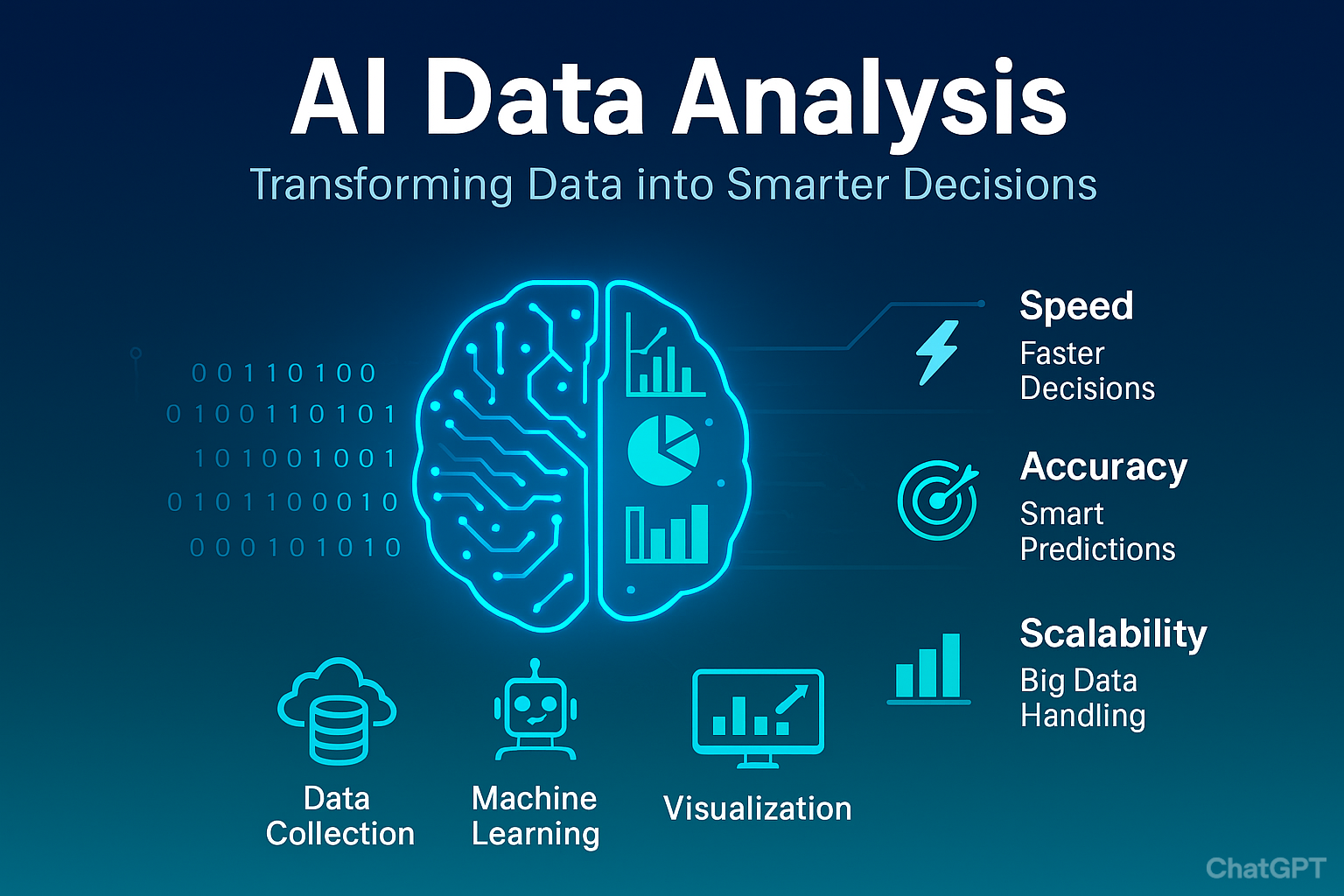Discover how AI Data Analysis transforms raw data into actionable insights, boosts efficiency, and powers smarter business decisions in 2025.
📑 Table of Contents of AI Data Analysis:
-
Introduction to AI Data Analysis
-
Importance of Data in the Modern Era
-
Role of Artificial Intelligence in Data Processing
-
Core Components of AI Data Analysis
-
Data Collection
-
Data Cleaning
-
Machine Learning Models
-
Visualization Tools
-
-
Benefits of AI Data Analysis
-
Applications in Different Industries
-
Healthcare
-
Finance
-
Retail & E-Commerce
-
Manufacturing
-
Education
-
-
AI vs Traditional Data Analysis
-
Challenges in AI Data Analysis
-
Ethical Concerns & Data Privacy
-
Future Trends in AI Data Analysis
-
Step-by-Step Process of AI Data Analysis
-
Tools & Platforms for AI Data Analysis
-
Real-World Case Studies
-
FAQs
-
Conclusion
1. Introduction to 🌟AI Data Analysis:
AI Data Analysis is the process of using artificial intelligence techniques like machine learning, natural language processing, and predictive analytics to interpret large volumes of data. In today’s digital economy, businesses generate massive amounts of raw data every second. AI acts as a bridge to turn this raw data into useful insights that drive decision-making, efficiency, and innovation.

2. Importance of Data in the Modern Era
Data is called the “new oil” because of its immense value. From customer preferences to financial records, every action generates data. Without analysis, this data remains meaningless. AI ensures that data is processed quickly and accurately.
3. Role of Artificial Intelligence in Data Processing
AI automates and enhances data analysis through:
-
Pattern Recognition: Identifying hidden trends.
-
Predictive Modeling: Forecasting outcomes.
-
Automation: Reducing manual work.
-
Scalability: Handling massive datasets.
4. Core Components of AI Data Analysis:
Data Collection
Gathering raw data from multiple sources like IoT devices, social media, business apps, and sensors.
Data Cleaning
Removing errors, duplicates, and irrelevant details to improve data quality.
Machine Learning Models
Using algorithms to detect patterns, classify data, and make predictions.
Visualization Tools
Creating charts, dashboards, and graphs that make insights understandable.

5. Benefits of AI Data Analysis:
-
✔ Faster decision-making
-
✔ Cost reduction through automation
-
✔ Improved customer experience
-
✔ Enhanced accuracy in forecasting
-
✔ Competitive edge in business strategies
6. Applications in Different Industries in AI Data Analysis:
Healthcare
AI analyzes patient records and predicts diseases early.
Finance
Used in fraud detection, risk management, and trading strategies.
Retail & E-Commerce
AI studies buying behavior and personalizes recommendations.
Manufacturing
Predictive maintenance of machines saves downtime.
Education
AI tracks student performance and customizes learning paths.
7. AI vs Traditional in AI Data Analysis:
| Feature | Traditional Analysis | AI Data Analysis |
|---|---|---|
| Speed | Slow | Fast, Real-Time |
| Accuracy | Manual Errors | High Precision |
| Scalability | Limited | Large Datasets |
| Predictive Ability | Low | High |
8. Challenges in AI Data Analysis:
-
Data privacy and security issues
-
High cost of implementation
-
Requirement of skilled professionals
-
Algorithmic bias
9. Ethical Concerns & Data Privacy
AI must follow strict guidelines to avoid misuse of personal data. Transparency, fairness, and security are key ethical pillars.
10. Future Trends in AI Data Analysis
-
Real-time analytics for instant insights
-
AI-powered automation across industries
-
Integration with blockchain for secure data sharing
-
Self-learning systems for higher accuracy
11. Step-by-Step Process of AI Data Analysis:
Define the problem
-
Collect data
-
Clean and preprocess data
-
Train AI models
-
Test and validate results
-
Deploy into real systems
12. Tools & Platforms for AI Data Analysis
-
Python (TensorFlow, Scikit-learn)
-
R Programming
-
Power BI & Tableau
-
Google Cloud AI
-
IBM Watson Analytics

13. Real-World Case Studies
-
Amazon uses AI data analysis for personalized shopping.
-
Netflix applies AI to recommend movies based on user activity.
-
Tesla relies on AI-driven data for autonomous driving.
14. FAQs
Q1. How is AI Data Analysis different from Business Intelligence?
👉 AI is predictive and automated, while BI is mostly descriptive.
Q2. Do small businesses need AI Data Analysis?
👉 Yes, even small firms can optimize sales and marketing with AI insights.
Q3. Which skills are needed for AI Data Analysis?
👉 Data science, machine learning, statistics, and visualization.
Q4. Is AI Data Analysis costly?
👉 Initial setup may be costly, but long-term ROI is high.
Q5. Can AI completely replace human analysts?
👉 No, AI supports and enhances human decision-making but cannot fully replace intuition.
15. Conclusion
AI Data Analysis is no longer just a luxury—it’s a necessity. From improving decision-making to enhancing customer experience, AI-driven insights transform how businesses operate. Companies that embrace AI Data Analysis today will gain a massive competitive edge in the future.
📌 Learn more at https://www.ibm.com/industries
Also visit this :https://sampurnjankari.com
